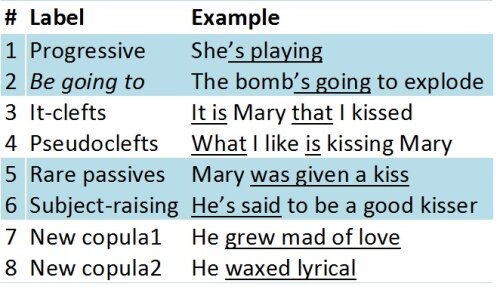Case studies
To examine innovation and clustering in mental grammars, the following eight syntactic structures are studied:

Structures such as these are generally acquired in childhood through subconscious learning, similar to the early development of face recognition or depth perception in the visual system. None of these are easily changed once acquired. Yet subtle changes are possible, much like a professional racecar driver probably has different depth perception than during his childhood. Similarly, when adults hear a structure being used in a novel way, they may do nothing or they may gradually pick up the change. Picking up the change may trigger another change or changes. The two may then coevolve, repeatedly influencing each other. For instance, the so-called progressive (be playing/running/...) basically means be busy doing something. Be going to originally was a subtype of this structure. Yet after 1600 it acquired independence in expressing future actions. Despite having split, there is global evidence that both began to expand to non-living subjects. The project will uncover if this also involves coevolution in 17th century individuals.
The next question is: can coevolution also involve less closely related structures? While each case changes much in the 17th century, warranting separate study, the changes may also be linked. Six out of the eight cases all started as novel structures sharing subject-verb word order. Until c1500 time adverbs (Then ran he), focal elements (Eve loves he) or empty subjects (They say he’s nice) could precede the verb. After, this position got restricted to subjects that are topics (He ran). Progressives need no time adverbs, clefts move the focal element, and passivization/subject-raising align topic & subject; all of this helped to realize the new order. If an abstract factor such as word order is found to cause several changes to cluster, this will teach us much about the optimization strategies of the mind. The remaining two cases (grow and get used as linkers, e.g. grow crazy) serve as a control group. Their structural independence in terms of word order makes it possible to isolate social factors from purely cognitive optimization.